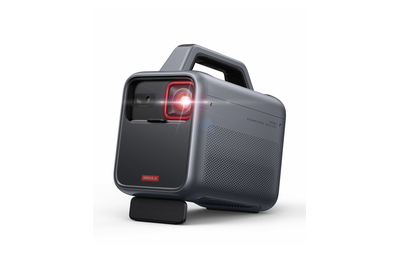The 2 Best Outdoor Projectors of 2025

Top pick
The Nebula Mars 3 is the best outdoor projector because it has the essential features necessary to deliver an enjoyable outdoor experience, and it provides good picture and sound quality to boot.
It was the brightest battery-powered projector in our tests. On our 100-inch screen, we measured 604 lumens with the Mars 3 in its best-looking picture mode, Custom. The projector’s even brighter but overly green Performance mode got closer to Nebula’s claimed spec of 1,000 ANSI lumens.
The Mars 3 is significantly brighter than all the smaller portables we tested — and twice as bright as its main outdoor-centric competitor, the BenQ GS50. That improved brightness gives the image more pop, but more important, it lets you go bigger in screen size. Although an image measuring 100 inches diagonal may seem quite large in an enclosed family room, it doesn’t feel as immersive in a big backyard. With this projector, you have the flexibility to go larger, within reason.
The picture quality is good. In our tests, this projector’s image contrast and color accuracy were solid — not quite as good as what we got from the lower-priced Mars 3 Air, but still above-average in the portable category. Although bright scenes veered a little bluish-green in the overall white balance, that helped to lend more perceived brightness to the picture.
We preferred the Custom picture mode over the Movie mode because it allowed us to turn down the sharpness control to remove some artificial edges that created a less natural look. But otherwise the two modes were similar. The Mars 3 supports 3D playback and has MEMC motion smoothing if you like that style of motion.
This projector has a 1080p resolution, which allows for a sharp, well-detailed image at larger sizes. We did not see as much of the visible pixel structure (that is, the grid of tiny little squares or the screen-door effect) in this model’s image as we did with the cheaper Mars 3 Air.
The Mars 3 also has the longest battery life. With the projector at 100% brightness, its battery came in right around the two-hour mark. With the projector’s eco mode (20% brightness), we got 4 hours 45 minutes of battery life.
Whereas many other portable projectors give you only a couple of brightness modes to choose from, the Mars 3 has an adjustable slider for you to precisely fine-tune the brightness based on how much battery life you need for any given movie. For example, you can probably get through a full kids movie at 100% brightness, but for Mission Impossible: The Final Reckoning, you may want to set it closer to 50%.
Also remember that this projector is more than twice as bright as most competitors, so you can turn down the brightness to extend the battery life and still get better brightness than you’d find on many other models.
When you don’t need battery power, the Mars 3 runs off standard DC power, with a detachable power cable that has a rather bulky power brick in the middle.
The speaker system is a difference-maker. We originally considered making the more affordable Mars 3 Air our top pick and designating this model as an upgrade pick. But once I tested both models outside in my large backyard, it became clear that this projector’s more dynamic speaker system made this model the better self-contained option.
The system produced a large, full sound that was respectably well balanced. And the Outdoor sound mode was quite effective at making the system sound even louder when the projector was outside, yet it still produced clear vocals.
Regardless, thanks to the Mars 3’s inclusion of Bluetooth support, you can easily connect an even more powerful portable Bluetooth speaker if you prefer.

This projector has an outdoor-friendly design. The build feels quite rugged and substantial, with a rigid carrying handle integrated into the top panel. The projector has an IPX3 water-resistance rating, as well as drop resistance. A rubber door covers the connection panel around back, while the lens up front is protected by a flip-down door that also powers the projector on and off easily.
On the underside you’ll find a threaded screw for tripod mounting and an adjustable flap that allows you to aim the projector higher when needed. To use the threaded screw with a tripod, you have to fully extend the flap.
You also get an integrated LED lantern with three brightness levels, which can be helpful for seeing the buttons on the non-backlit remote control in the dark. Another LED dial provides visual feedback on battery life, and a set of control and navigation buttons is positioned on the carrying handle in case you’ve left the remote indoors.
Last but not least, the projector has USB-A and USB-C charging ports on the back to power your mobile devices. But using them drains the battery faster.
Android TV is built in. Although we like Google TV a little more, the Mars 3’s fully integrated Android TV operating system makes it easy to stream video and audio content when you have a Wi-Fi connection nearby, such as when you’re set up in the backyard or able to create a mobile hotspot. All the major services, except Netflix (see below), are present.
For times when you can’t stream over Wi-Fi, one HDMI input is available for connecting a laptop or mobile device, though you’re likely to need some form of an adapter cable to do that.

The automatic image adjustments are hit-and-miss. The projector’s Intelligent Environment Adaptation technology uses a combination of automatic focus, keystone correction, obstacle avoidance, and screen fitting to quickly shape a level, rectangular image on whatever surface you’re using (hopefully a projector screen).
In our tests, the automatic focus worked quickly and effectively to create a clear, sharp-looking picture. We were less enthusiastic about the automatic keystoning and screen-fitting image-shaping tools, as the results never aligned perfectly with our outdoor screen. But we got excellent results when we turned off the auto adjustments and did the keystoning manually with the remote control, which was super easy and took just a few seconds.
If possible, try to avoid using keystone correction altogether. It adds an extra layer of video processing that hurts the projector’s clarity and, for gaming, adds lag. Mounting the projector on a tripod can help, since the tripod gives you more flexibility in adjusting the projector’s height and angle.
Flaws but not dealbreakers

Its weight and size demand a sturdy tripod mount. Measuring 6.3 by 10.2 by 9.8 inches and weighing 9.9 pounds, the Mars 3 is larger and heavier than most portable projectors. If you want to use it with a tripod, you need a sturdy one to secure it; we used the Wirecutter-recommended Vanguard Alta Pro 2+ with good results.
You have to sideload Netflix. Like many Android TV projectors, this one lacks native support for Netflix. You have to “sideload” Netflix through the Nebula Play app, a process that adds only a couple of steps. But then the remote control doesn’t work as effectively to navigate the interface; you’re better off using the Nebula Connect control app or the navigation tools on the Mars 3’s carrying handle.
It lacks USB video ports. That means you can’t connect a USB-A thumb drive loaded with video. In addition, to attach USB-C mobile devices, you need an HDMI adapter cable. We used this Insignia cable.





